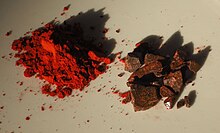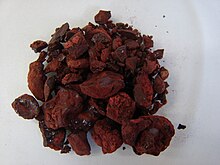Dragon blood (resin)


Dragon's blood (Latin sanguis draconis ) is a red-brown natural resin from various plants, which is used as a phytopharmaceutical (herbal remedy) and as a coating material and dye .
history
The name dragon's blood for the resin of Dracaena cinnabari appears for the first time in Dioscorides , Pliny the Elder and other ancient poets. According to Pliny, the name dragon's blood ( Latin Sanguis Draconis ) is based on a battle between an elephant and a dragon-like creature. The fight caused the blood of the two animals to mix. The resin was said to have magical properties and was valued by the Greeks , Romans and Arabs for its supposed medicinal properties.
During the time of the Roman Empire, the resin was transported by the Arabs to Europe via Bombay or sometimes via Zanzibar , which led to the name "Zanzibar Dragon's Blood". In Arabic is bothدم التنين (dam at-tinin, dragon's blood) as well دم الاخوين (dam al-akhwain, blood of the two brothers) in use.
Dragon blood (in Middle High German also trachenbluot and similar forms; Latin sanguis draconis ) originally referred to a resin ( Dracaena cinnabari ) from the island of Socotra in the Gulf of Aden , Dracaena ombet , on the Somali coast, and - in Europe, however, only from the 18th century - The resins of the fruit scales of the Daemonorops draco palm in Southeast Asia . The name extended to other similar resins obtained from plants of the genera Daemonorops , Dracaena (dragon trees), Croton (a genus of the milkweed family ) and Pterocarpus (a genus of the legumes ). In addition, in historical literature ( Sanguis Draconis , Chinese 血竭 - "drawn blood") the name is also common for cinnabar ( cinnabarite ) and other red essences.
Socotrian dragon blood is mentioned in the Periplus Maris Erythraei , a 1st century sea trade register for the Pacific Ocean , and was traded on the Frankincense Route . Canarian dragon blood of Dracaena draco has been imported to Europe via Spain since the beginning of the 15th century .
Texture and composition
Dragon blood is a resin that belongs to the group of oleoresins . It consists of about 60% Dracoresin , a red ester resin , as well as about 14% Dracorresen and 2.5% Dracoalban . The main pigment , however, is dracorubine C 32 H 24 O 5 , which is less than 1%.
Dragon blood is insoluble in water , petroleum , turpentine and ether . It dissolves to varying degrees in alcohols , acetone , acetic acid and glycerine as well as in other solvents. Depending on its purity and origin, it melts between 60 ° C and 100 ° C and emits red, strongly irritating gases when heated .
The commodity of the resin is opaque red-brown to brown-red, with shiny breakage and up to a quarter with plant remains and other things. The taste of the resin is sweet, sometimes scratchy.
Extraction and trading
Daemonorops dragon's blood (East Indian dragon's blood) comes mainly from southern India , Borneo , Sumatra and the Moluccas . The resin is found in brittle layers that are arranged like roof tiles on the surface of the unripe fruit. The unripe fruits, about the size of a cherry, are collected and dried. Only the unripe fruits are used, as the fruits crack during the ripening process and the resin leaks out. After the fruit has dried, the resinous powder is softened by heat and can then be shaped into stick-shaped pieces or cakes weighing pounds.
On the other hand, dragon blood comes from China from the species Dracaena cambodiana and Dracanea cochinchinensis .
In order to approach the resin of Croton spp. and Dracaena spp. To get there, you have to cut the tree or at least twist it. Then you can win the juicy, dark red resin.
Socotrian dragon blood is obtained from Dracaena cinnabari (Socotrian dragon tree). The resin exudes from the trunk and is harvested in a similar way to natural rubber by enlarging the natural seepage cracks. The drying resin is then scraped off the tree. Canarian dragon blood from Dracaena draco is similar . Due to the rarity of wild dragon trees on the Canary Islands, dragon blood has not been extracted here for a long time.
American dragon blood comes from plants native to the West Indies ( pterocarpus ).
Useful plants for dragon blood are:
- Croton : Croton draconoides trash.Arg. , Croton draco Schltdl. & Cham. , Croton lechleri Müll.Arg. , Croton salutaris , Croton palanostigma , Croton urucurana Baill., Croton erythrochilus Müll.Arg. , Croton gossypiifolius Vahl. , Croton xalapensis Kunth.
- Daemonorops : Daemonorops draco flower (dragon's blood palm ), Daemonorops didymophylla Becc. , Daemonorops micracantha Becc. , Daemonorops rubra (Reinw. Ex Mart.) Blume u. a.
- Dracaena : Dracaena cinnabari Balf.f. , Dracaena draco (L.) L. , Dracaena cochinchinensis Hort. ex Baker , Dracaena cambodiana Pierre ex Gagnep. , Dracaena ombet Heuglin ex Kotschy & Peyr.
- Pterocarpus : Only from Pterocarpus officinalis Jacq.
Dragon blood comes in fragments, cakes weighing a kilo or shellac -like in flakes , and in the past also in sticks wrapped with reed and rosary- like grains.
Today, most dragon blood resin for commercial use is obtained from the unripe fruits or fruit scales of the Daemonorops rattan palms .
use
The carmine-red resin was already highly valued in ancient times and was used there as a coloring agent for paints, toothpastes, plasters and tinctures. In China, furniture, paper and posters were colored.
Dragon's blood was used externally for scurvy and in wound treatment as an antiseptic , internally for diarrhea and respiratory diseases as well as incense and in embalming . The resin of the dragon's blood tree was also used as an ingredient in ointments, for example for the treatment of syphilis . It has lost its medical importance and is still used in Chinese medicine . In the Middle Ages, described in Circa instans , sanguis draconis was replaced by garden cumin powder as a counterfeit medicine .
In violin making, carpentry and restoration, dragon's blood is used for lacquers, tinted varnishes and color mixtures. The finest dragon blood resembles madder .
Dracorubin paper is an indicator paper to differentiate between benzene (red color) and petrol (brown color).
In chemigraphy (American zinc etching) in photo technology, it is used as an etching base .
As a traditional incense , dragon's blood is used by the Quiché tribe in Guatemala in their sacrificial ceremonies to appease the gods.
literature
- Georg Kremer: 37000, 37011 Dragon's Blood . Ed .: Farbmühle Kremer Pigments . ( kremerpigmente.com [accessed October 2, 2016]).
- Evans OP Agbakwuru, W. Basil Whalley: The pigments of 'dragon's blood' resin . In: J. Chem. Soc., Perkin Trans. 1 . 1976, p. 1392-1394 , doi : 10.1039 / P19760001392 .
- Friedrich Ernst Beyhl: Notes on the Dragon's Blood and the names of the island of Soqotra. In: Journal of the German Oriental Society . Volume 148, 1998, pp. 35-82.
- Hugo [Emile] Lojander: Contributions to the knowledge of the dragon's blood. Inaugural dissertation from the Faculty of Mathematics and Natural Sciences at the Kaiser Wilhelms University of Strasbourg. Buchh. Karl J. Trübner, Strasbourg 1887, Kessinger Pub . Co., 2010, ISBN 978-1-162-37876-3 (reprint).
- Lisa Takler: Volatile compounds and antimicrobial effects of selected resins and balms from A – J. Diploma thesis, University of Vienna, 2015, pp. 43–50, online (PDF; 3.18 MB), at ubdata.univie.ac.at, accessed on November 1, 2016.
- Kurt Holle: About new dyes from Indian dragon blood. Dissertation, University of Freiburg im Breisgau, Faculty of Science and Mathematics, December 21, 1945, DNB 481681655 .
Web links
Individual evidence
- ↑ See also Jürgen Martin: Die 'Ulmer Wundarznei'. Introduction - Text - Glossary on a monument to German specialist prose from the 15th century. Königshausen & Neumann, Würzburg 1991 (= Würzburg medical-historical research. Volume 52), ISBN 3-88479-801-4 (also medical dissertation Würzburg 1990), p. 167 and 179.
- ↑ Dieter Martinetz, Karlheinz Lohs, Jörg Janzen: Weihrauch and Myrrhe. Cultural history and economic importance. Botany, chemistry, medicine. Wissenschaftliche Verlagsgesellschaft, Stuttgart 1989, ISBN 978-3-8047-1019-1 , p. 35 f.
- ↑ a b c d e f g h Georg Kremer: 37000, 37011 Dragon's Blood . Ed .: Farbmühle Kremer Pigments . ( kremerpigmente.com [accessed October 2, 2016]).
- ↑ Anonymous: Periplus Maris Erythraei 30: 10. 17.
- ↑ External identifiers or database links to Dracorubin : CAS number: 6219-63-2, PubChem : 160270 , ChemSpider : 140866 , Wikidata : Q27106444 .
- ^ Paul Heinz List, Ludwig Hörhammer: Hagers Handbook of Pharmaceutical Practice . 4th edition, Springer, 1979, ISBN 978-3-642-66378-9 , pp. 60 ff.
- ^ A b c d Justus von Liebig , Johann Christian Poggendorff , Friedrich Wöhler : Dracenin. - Dragon blood . In: Concise dictionary of pure and applied chemistry . 1862, p. 486 f . ( books.google.de ).
- ↑ Joanna Jura-Morawie, Mirela Tulik: Dragon's blood secretion and its ecological significance. In: Chemoecology. 26, 2016, pp. 101-105, doi: 10.1007 / s00049-016-0212-2 .
- ↑ Volker Zimmermann: The two Harburg syphilis tracts. In: Würzburg medical history reports. Volume 7, 1989, pp. 71-81; here: p. 72 f. Königshausen & Neumann, Würzburg, ISSN 0177-5227
- ↑ Konrad Goehl : Observations and additions to the 'Circa instans'. In: Medical historical messages. Journal for the history of science and specialist prose research. Volume 34, 2015 (2016), pp. 69-77, here: p. 70.
- ↑ Dragon's Blood (resin). Retrieved April 14, 2016 .

